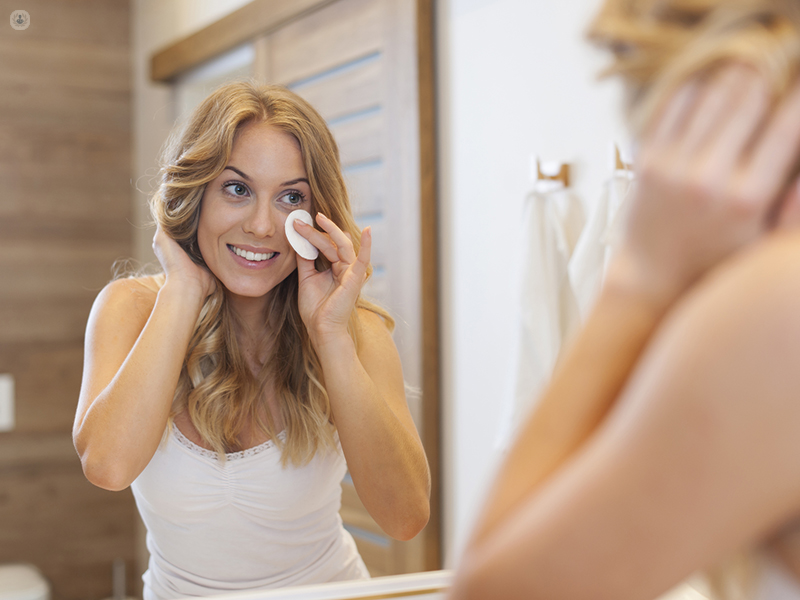Meibomian gland dysfunction and blepharitis explained
Written by:Meibomian gland dysfunction and blepharitis are eye conditions that overlap. Both affect the eyelid, but while blepharitis affects the front of the eyelid, meibomian gland dysfunction affects the back. Mr Myer Mark Yodaiken, an experienced ophthalmologist talks to us about both meibomian gland dysfunction, also known as posterior blepharitis, and blepharitis or anterior blepharitis.

What is blepharitis?
When deposits build up on the eyelashes, this is known as anterior blepharitis. This can occur due to an infection or from a build-up of particles like dirt and dust. When deposits build up, this can lead to a build-up of bacteria that can leak into the eye. This can cause the eye to feel gritty, itchy or cause a burning sensation. Anterior blepharitis can be easily treated at home.
Read more: what causes blepharitis?
What is Meibomian gland dysfunction?
At the back of the eyelid, lies the meibomian glands and this is where you will find meibomian gland dysfunction or posterior blepharitis. Meibomian gland dysfunction is typified by a dysfunction in the meibomian gland as a result of very poor oil production. When oils are produced, the oils block the gland and the gland begins to produce poor quality oils. The poor quality of the oils means that there is an insufficient oil layer to cover the cornea. The function of the oil layer is to prevent evaporation, so with an insufficient oil layer, evaporation increases, leading to dry eye syndrome or what’s known as evaporative dry eye.
What symptoms are typical of Meibomian gland dysfunction?
The symptoms of meibomian gland disease can be numerous, such as:
- A burning sensation in the eye
- Fatigue
- A foreign body sensation in the eye
- Dry eyes
- Intermittent blurring of vision
How do we diagnose Meibomian gland dysfunction?
Meibomian gland disease can be difficult to diagnose and sometimes allergies or other pathologies are mistakenly diagnosed as MGD. Often blepharitis and MGD coexist with other dry eye conditions. It’s important to treat any underlying conditions and to treat any existing damage to the cornea to improve the condition of the eye. Damage to the cornea can make the eye feel uncomfortable and put it at a greater risk of infection.
Treating blepharitis
Anterior blepharitis can easily be dealt with at home as it just involves cleaning your eyelids with special wipes that are available from the pharmacy. Diluted baby shampoo was previously used to treat patients, but it was found to upset the tear film layer, worsening the disease, so this should be avoided at all costs.
Treating Meibomian gland dysfunction
Hot compresses are really the mainstay of treatment. They increase heat to the lid, melting the oils, making it easier for the oils be released. Along with the heat, pressure needs to be applied to the lids, otherwise, the melted oils will re-solidify and won’t come out.
If this doesn’t work, the best method to unblock the oil glands is to use LipiFlow. LipiFlow is the gold standard computer-controlled procedure that heats the eye from the back of the lid, so no heat damage can occur to the cornea itself. At the same time, pressure is placed on the eye to extrude all the oils. Once the glands are emptied, they can recover and produce normal oils, improving dry eye symptoms and your quality of life.
LipiFlow or similar treatments will prevent long-term atrophy which will occur if you don't treat dry eyes in the first place. Although the disease may come back, the final outcome will be much improved with significantly reduced atrophy in the long term.
How to tackle dry eyes
When there are evaporative changes in the eye, tears become hyperosmolar - there’s a high concentration of salts in the tears which leads to inflammation in the eye and damages the cornea.
To treat dry eyes, which are a symptom of both blepharitis and meibomian gland dysfunction, your ophthalmologist will advise you to use artificial tears or steroid drops to reduce inflammatory changes in the eye. They will also advise you to add more omega-3 to your diet or to take supplements. Omega-3 is very good for changing the consistency of the oils in the eyes, as well as reducing inflammatory changes around the eye.
For more on dry eyes and the meibomian glands or to make an appointment with Mr Yodaiken, please visit his profile on Top Doctors.


